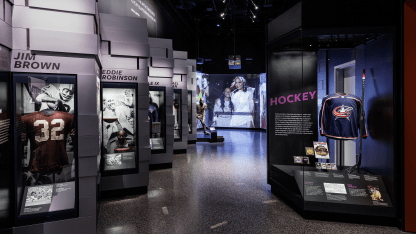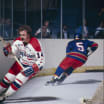The Smithsonian's National Museum of African American History and Culture (NMAAHC) has installed a new exhibition case dedicated to hockey. On view in the "Sports: Leveling the Playing Field" gallery, the exhibition explores hockey's early history and Black athletes' contributions, which extend to the late 19th century. Alongside the hockey case is a new statue honoring the first Black player in the National Hockey League (NHL), Willie O'Ree.
NMAAHC's New Exhibition Case Features Black Athletes in Hockey
Commissioned Statue Honoring National Hockey League's First Black Hockey Player, Willie O'Ree, Now on Display

The Colored Hockey League (CHL) was founded in 1895 by descendants of African Americans that escaped slavery and fled north. Among that group were roughly 30,000 formerly enslaved African Americans that sailed to Canada after fighting alongside British troops during the American Revolution and the War of 1812. As the museum explores the widespread legacies of slavery, hockey provides an entry point to explore the experiences of African Americans who sought a life better than the one they had in the United States. Years later, their descendants created a hockey league that helped develop the modern game.
"The skill, creativity and athletic abilities of these players were unmatched and defied the belief that Black athletes were incapable of playing such a sport," said Damion Thomas, NMAAHC's curator of sports. "Their story is one of resilience and determination, mirroring that of their ancestors who migrated north to escape slavery. These athletes invested in a pastime that brought a sense of comradery and community to Black Canadians and immigrants in Canada."
Although the league was active for a brief time (1895-1930), the legacy of these Black hockey players and the all-Black league is evident today through the rising number of Black players in the NHL, most of whom hold roots from throughout the African diaspora, including Jamaica, Haiti, Canada, the United States and Nigeria. However, even after the first Black player joined the game in 1958, the presence of Black hockey players in the NHL has been slow to increase, reaching a record high of 28 players in the 2017-18 season.
"This story of hockey-the full story-acknowledges Black athletes' crucial role in shaping hockey as we know it today and tells a more inclusive history of not just hockey but the enduring legacy of slavery," Thomas said.
Several objects from the museum's collection are on view showcasing the history of the Black hockey league in Nova Scotia, Canada, known as the CHL, in which players pioneered various innovations like butterfly goaltending, a technique goaltenders use to block attempts to score. Also included are objects from Ice Hockey in Harlem and the Fort Dupont Ice Hockey Club, two hockey programs that use the sport to encourage diversity and personal development in African American youths. In addition, objects from outstanding African American NHL players like Seth Jones and Joel Ward are on display.
Featured objects in the hockey-exhibition case include:
Willie O'Ree Statue
Born in Fredericton, New Brunswick, Canada, O'Ree began his hockey career at the age of 15 playing for the Fredericton Falcons in the New Brunswick Amateur Hockey Association. In the 1955-56 season, O'Ree joined the Kitchener Canucks of the Ontario Hockey Association as a junior scorer, where he lost 95% of the vision in his right eye after being hit by a puck. On Jan. 18, 1958, O'Ree became the first Black player in NHL history when the Boston Bruins called him up from the minor leagues. The media often referred to him as the "Jackie Robinson of Ice Hockey."
Although O'Ree's career in the NHL spanned only 45 games over two seasons, he made a lasting impression on the lives of aspiring Black hockey players who followed in his footsteps, such as Vegas Golden Knights forward Ryan Reaves, New Jersey Devils defenseman P.K. Subban, New York Rangers defenseman K'Andre Miller, Toronto Maple Leafs forward Wayne Simmonds and Los Angeles Kings forward Quinton Byfield. Byfield became the highest-drafted Black player in NHL history in 2020.
O'Ree was inducted into the Hockey Hall of Fame in November 2018 and into Canada's Sports Hall of Fame in May 2020. He is currently an NHL Diversity ambassador for the League's "Hockey Is for Everyone" initiative, a year-round campaign reinforcing that the official policy of the sport is one of inclusion on the ice, in locker rooms, boardrooms and stands. The honorary statue of O'Ree can be seen in the museum's "Sports: Leveling the Playing Field" gallery, which explores the contributions of athletes on and off the field.
Visit the Museum
The museum is open Wednesdays through Sundays 11 a.m.-4 p.m. To protect visitors' and staff's health, the museum has limited the number of available passes to enter the museum. During this time, the museum cannot accommodate any walk-up visitors. For more information on visiting the museum and safety guidelines, visit
https://nmaahc.si.edu/visit/plan
.
About the National Museum of African American History and Culture
Since opening on Sept. 24, 2016, the National Museum of African American History and Culture has welcomed more than 7 million visitors. Occupying a prominent location next to the Washington Monument on the National Mall in Washington, D.C., the nearly 400,000 square-foot museum is the nation's largest and most comprehensive cultural destination devoted exclusively to exploring, documenting, and showcasing the African American story and its impact on American and world history. For more information about the museum, visit nmaahc.si.edu, follow @NMAAHC on Twitter, Facebook and Instagram, or call Smithsonian information at (202) 633-1000.


















